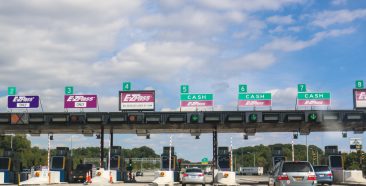
For those unfamiliar with auto insurance, reading and understanding your auto insurance policy may feel like hard work. Even after an agent has walked you through your policy, it can still seem like too many words to bother with reading.
Thankfully, the insurance industry and government regulators have defined common and specific terms so that providers and buyers have a standard way to communicate insurance ideas.
And, there aren’t many terms you’ll need to understand in order to make sense of your types of coverage. Many of those terms can be found in your insurance policy, the document detailing your insurance terms and conditions.
What are Standard Insurance Policy Terms?
Standard insurance policy terms are common to all policies. We say standard, but there may be some differences between providers. Still, insurance policies are legal contracts and must outline specific requirements common across all providers, so look for these exact terms or something very close.
Your insurance policy will typically be subdivided into a few primary sections. Once you understand these sections, most of the mystery of an insurance policy will disappear, making you better prepared to understand your auto insurance policy protections and become a better insurance shopper.
The primary sections of insurance policies include:
- Car Insurance Declaration Page
- Agreement
- Definitions
- Insuring Agreement
- Conditions
- Coverages
- Coverage Payment Limits
- Deductibles
- Exclusions
- Insurance Endorsements and Riders
Let’s examine these one by one.
Car Insurance Declaration Page
An insurance policy’s declaration page is usually its first page. It summarizes the policy details, containing the most useful policy information so that there is no confusion about the auto liability coverages and limits, deductibles, and the policy’s effective dates. This is also some of the same information present on your wallet-sized insurance card, readily available if police should ask for it.
These are the common parts of a declaration page:
- Insurance provider
- Policyholder name – named insured policyholder
- Policy number — your unique policy number
- Policy period – the effective dates of your insurance policy
- Driver(s) listed – list of main drivers of the vehicle, and any excluded drivers
- Vehicle(s) listed – automobiles covered
- Coverage – the damage or injuries an insurance company agrees to pay for under the policy
- Coverage limits – the maximum amount your insurance company will pay for each covered accident, for each type of coverage
- Deductible – the amount you owe in a loss before the company pays its part
- Premium – the amount you pay an insurance company for your policy
- Endorsements – policy changes that give you more or less coverage and may change your premium
What is a Dec Page? – Office of Public Insurance Counsel
The Policy Agreement Section
The Agreement section states that you, as the policyholder, agree to pay a specific premium, displayed on the declaration page, for your insurance coverage types. This is your side of the contract. Note, you are not actually obligated to pay your premium. Anytime you don’t want the coverage, simply stop paying premiums, and your provider will cancel the policy.
Definitions Section to Dispel Confusion
Because specific terminology is used throughout your policy with common everyday meanings, the Definitions section spells out exactly what certain words in the context of this policy mean to prevent confusion.
Take “family member,” for example. If it is defined in your policy as “a person related to you by blood, marriage or adoption who is a resident of your household,” this means your policy could exclude covering your child living away at college, even though you still consider them family members.
Insuring Agreement Spells Out Insurers Obligations
Often right after the declaration page comes the Insuring Agreement. The Insuring Agreement is where the insurance provider explicitly outlines policy details and how it will cover the policyholder. It will start something like: We will pay damages for “bodily injury” (Coverage A) or “property damage” (Coverage B) for which any “insured” becomes legally responsible because of an auto accident.
The policy scope in this section is outlined broadly. Later, your kind of insurance coverage is narrowed down in the exclusions section by outlining the circumstances when your insurance won’t cover you, like driving intoxicated or driving for business.
The Conditions Section Outlines the Rules
In the Conditions section, the policy outlines the rules, provisions, obligations, and codes of conduct that the policyholder and insurance provider must follow to maintain the contract’s integrity. If you breach any of these conditions, you could lose your coverage, or your claim could fail.
Common conditions include proper documentation and timely filing of claims. To file a claim, you will need to do so within a specific time limit after the car accident. And when you do file, you will need to have detailed documentation to support your claim, like a police report. Failing to meet these parameters may disqualify your claim.
But not all conditions apply to the policyholder. For example, as a policyholder, you can cancel anytime simply by withholding your premiums; however, if the insurance provider wants to cancel the policy, they will be required to give you forewarning and a reason for cancellation.
Coverages is the Meat of the Policy
Your policy coverages are listed out in this section, depending on what you’ve included. The five common car insurance coverage types you will see in this section are Liability, Collision, Comprehensive, Personal Injury Protection (PIP), and Uninsured Motorist Coverage/Underinsured Motorist Coverage (UMC).
- Liability — This protection covers medical payments, repairs, and legal settlements of physical injuries or damage done to someone else’s person or property that was a result of an accident caused by you or someone other driver covered under your auto insurance policy. Liability insurance limits are broken down into a per person limit for bodily injury liability coverage, per incident limit for bodily injury, and a limit for property damage.
- Collision — Collision coverage is provided whenever your car is damaged in a collision with another vehicle or other object, regardless of who was at fault.
- Comprehensive — Comprehensive coverage pays for theft or damages caused by something other than a collision such as fire, hail, windstorms, falling objects, or contact with wild animals. This type of insurance varies, so pay attention to what specific events are covered or excluded in the comprehensive coverage portion of your overall policy.
- Personal Injury Protection (PIP) — Sometimes known as No-Fault insurance, PIP will help pay the policyholder’s medical bills and any passengers in the insured vehicle that were injured during an auto accident, regardless of who was at fault. This medical payments coverage might also pay for lost wages and funeral costs.
- Uninsured Motorists Coverage / Underinsured Motorist Coverage — Uninsured motorists coverage insurance will make payments for damages done to you or other members under your policy if a driver strikes them with no auto insurance or who has insufficient auto insurance coverage to pay for all your damages.
Full coverage refers to collision coverage, comprehensive coverage and liability coverage in one package. Full coverage is often required for complete auto liability coverage from your lender. Optional coverage refers to anything you add to the basic types of coverage, such as non-required medical payments coverage.

Coverage Payment Limits Explains the Insurers Burden
Included with the auto liability coverages are the Coverage Payment Limits. This is the total amount that the company will pay out for a covered accident claim. If the amount you owe exceeds the limit listed on your policy, you’ll be responsible for paying the remaining amount.
Car insurance policies give their coverage limits as a string of numbers separated by a slash. It looks similar to 25/50/25 or $25,000/$50,000/$25,000.
These numbers breakdown into the policy limits according to liability coverage for bodily injury and property damage (limits for collisions and comprehensive are included when applicable):
- $25,000 of coverage for bodily injury (per person)
- $50,000 of coverage for bodily injury (per accident)
- $25,000 of coverage for property damage (per accident)
Let’s illustrate how this works. After running a red light, driver A winds up in a car accident with driver B, making the fault squarely on driver A. After everything was cleared, 3 of the people in driver B’s car went to the hospital, and the car was totaled. The total claims came to the following:
- Driver B, $16,000 in bodily injury
- 1st Passenger with Driver B, $27,000 in bodily injury
- 2nd Passenger with Driver B, $13,000 in bodily injury
- Driver B’s totaled car, $17,000 actual cash value
Driver B’s car was worth only $17,000 actual cash value and is entirely covered by driver A’s property damage coverage. The total bodily injury expenses came to $56,000, $6,000 more than driver A’s per-accident bodily injury coverage limit. Driver A must now pay out-of-pocket at least $6,000.
Deductibles Are the Amount You Owe Up Front
A deductible is the amount you are expected to pay before your auto insurance company starts paying for a claim. If your deductible is $1000, you will need to pay $1000 before your insurer steps in to cover up to their limits whenever you are in an accident. That means you need to keep $1000 available just in case of an accident.
Deductibles offset the insurer’s risk and influence your premium amount. If you are paying low premiums, your deductible is likely higher than if you are paying high premiums. So if you want a lower deductible, ask to pay a higher premium. If you want a lower monthly premium, set your deductible higher.
Exclusion Lists What You Are Not Covered For
The exclusions section narrows the broad coverage outline in the Insuring Agreement section by explicitly listing any other perils not covered by your insurance policy. Though some of these perils, like war or nuclear accidents, sound very unlikely to happen, other exclusions you might want to know about, like using your car for a delivery/ride-share business, can also negate your coverage. Here are some standard car insurance exclusions:
- Intentional damage or bodily injury, acts of rage, using your car in a criminal activity
- Government action or confiscation
- Driving while intoxicated
- Acts of nature such as tsunamis and volcanos
- Catastrophic events such as war and nuclear accidents
- Using your car for delivery/ride-share purposes
Insurance Endorsements or Riders Provide Additional Coverage
Insurance Endorsements and Riders are add-ons that provide additional coverage. This section outlines any add-ons or riders that are attached to your policy. Some typical riders include:
- Family Protection Coverage Endorsement — Increases your liability limits if an un-/underinsured motorist injures or kills you or one of your family members in an accident.
- Waiver of Depreciation — Cars lose 30% of their value once they’re driven off the lot. This endorsement covers your brand new car for its purchase amount, and if it’s totaled, you will get the entire amount back instead of adjusted for depreciation. But this rider only lasts for a period of time after the car’s purchase.
- Loss of Use — Provides a rental car if your car is damaged or needs to be replaced in a covered accident.
Now that you have a better understanding of how to read and understand your auto insurance policy, let’s talk about the kind of coverage you may need.
What are the Best Coverage Options for Me?
The best insurance for you depends on your vehicle and your situation. If you are driving a brand new car off the lot, you may want to consider a more robust insurance package. If your new car is stolen or totaled, you’ll want to be able to walk away with enough money from the insurance company to buy some new wheels.
If your car is a reliable, but old, model with plenty of mileage, you don’t want to pay more for insurance than the car is worth. For example, if your Kelly Blue Book value is $2,000, you most likely only need the minimum state-required insurance, plus uninsured motorist coverage, to protect you. Keep in mind, however, that if you cause an accident and you only have the minimum liability insurance, you may end up owing money out of pocket with today’s repair costs and hospital bills.
If you are relatively certain that you won’t be the cause of an accident and your car is not worth much, you don’t need to pay more for insurance than the car is worth. Understanding your auto insurance policy is the first necessary step.
Find Affordable Coverage with Online Quotes Today
After reading through your car insurance policy, do you think you deserve better coverage? Freeway Insurance can offer you a wide range of low-cost auto insurance plans and rates that meet your needs while saving you money. Visit us online, at an office near you, or call us at (800) 777-5620 for a quote.


